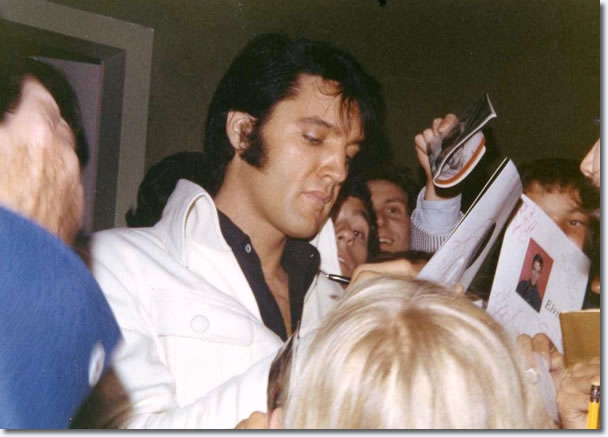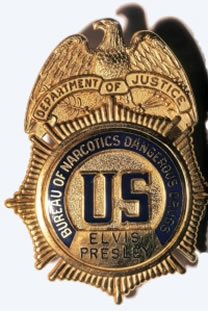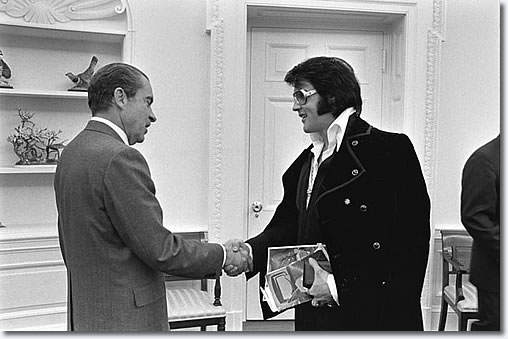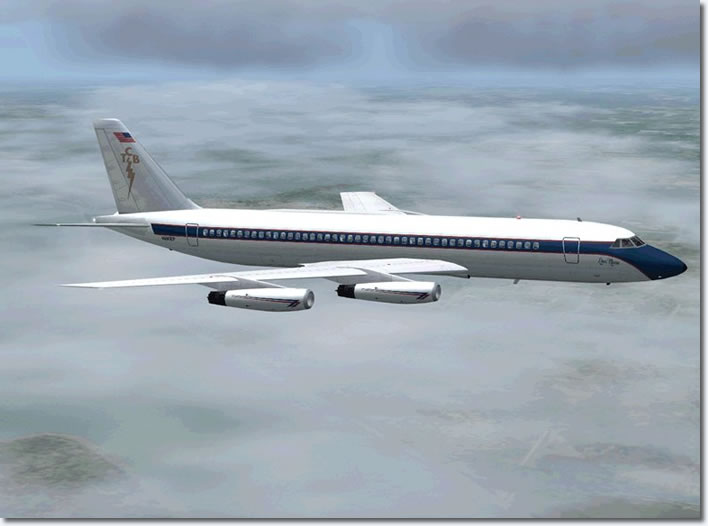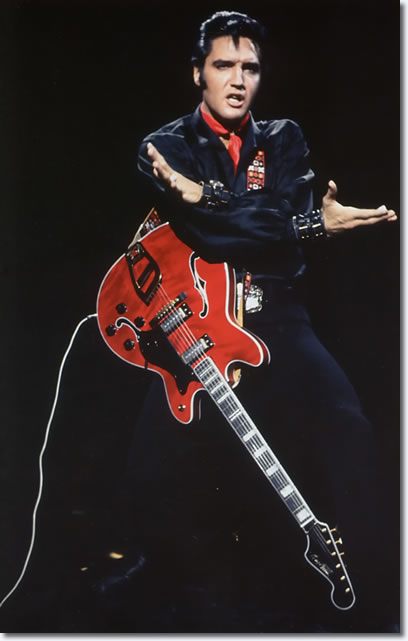Elvis Presley Biography
Elvis Aaron Presley was born to Vernon and Gladys Presley in a two-room house in Tupelo, Mississippi, on January 8, 1935. His twin brother, Jessie Garon, was stillborn, leaving Elvis to grow up as an only child.
Elvis and his parents moved to Memphis, Tennessee, in 1948, and Elvis graduated from Humes High School there in 1953. Elvis' musical influences were the pop and country music of the time, the gospel music he heard in church and at the all-night gospel sings he frequently attended, and the black R&B he absorbed on historic Beale Street as a Memphis teenager. In 1954, Elvis began his singing career with the legendary Sun Records label in Memphis. In late 1955, his recording contract was sold to RCA Victor. By 1956, he was an international sensation.
With a sound and style that uniquely combined Elvis' diverse musical influences and blurred and challenged the social and racial barriers of the time, he ushered in a whole new era of American music and popular culture. Elvis Presley's dynamic life story from his humble beginnings through his rise to stardom is a fascinating journey which has earned Elvis his still undefeated title of the 'King of Rock 'N Roll'.
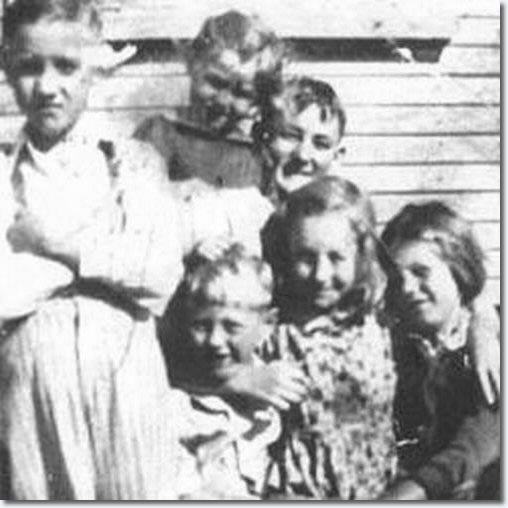
Tupelo Childhood Classmates @ Lawhon Junior High School in 1943.
Elvis Presley; Evon Farrar, now Mrs. Bobby Richey; James Farrar, Fourth District Justice of the Peace; (middle row)
Guy Harris, captain with the Tupelo Police. Photo courtesy of Guy Harris and Wanda Powell Heagy.
His songs are unforgettable - they have stood the test of time, especially his singles of the 1950s, a decade in which he had a song at No. 1. for a full 6 months of that year. An even more incredible statistic is Elvis only started at RCA in January of 1956, there is only two years until he is drafted in to the U.S. Army, he made 4 movies during this time. A testament to his incredible break-through is the fact that he managed to sell twice as many records in the entire decade of the 1950s with only these two years of recording than any other performer. (There were also the SUN years 1954-1955 but these were not huge foe record sales like when he became a national sensation in 1956).

Dixie Locke Elvis' girlfriend.
They were also unpredictable. Who could know what the next one would be like? Elvis liberally altered his style to suit each song. There were the early country-boy rockabillies sung in a breathless high pitch, of which My Baby Left Me,Milkcow Blues Boogie and Money Honey are examples. His more mature, aggressive rock 'n' roll stance came out with songs such as Blue Suede Shoes, One Night and A Big Hunk O' Love. his approach to ballads ranged from the ethereal vocal effects on the guitar-tapping version of Blue Moon to smooth crooning on As Long As I Have You, Can't Help Falling In Love and many other slow numbers and movie songs.
January 8, 1935
 Elvis Presley 1939.
|
Elvis Aaron Presley, in the humblest of circumstances, was born to Vernon and Gladys Presley in a two-room house in Tupelo, Mississippi on January 8, 1935. His twin brother, Jessie Garon, was stillborn, leaving Elvis to grow up as an only child. He and his parents moved to Memphis, Tennessee in 1948, and Elvis graduated from Humes High School there in 1953.
His First Guitar
On Elvis' eleventh birthday, his parents bought him a guitar. With the help of his uncle Johnny (Smith) and pastor Frank Smith of the Assembly of God Church, which the Presleys were now attending, he learned some basic cords. However while Elvis did play rhythm in the 1950's he never progressed further as a guitar player, content to let the guitar become more of a prop as time went on. When you have a voice as good as Elvis Presley's, you are not motivated to learn more, instead he concentrated on improving his voice to get it where he wanted, to be able to sing the bigger songs, like Are You Lonesome Tonight?, It's Now Or Never, both from 1960 and songs such asMy Way in the 1970s just to name but a few.
Getting to SUN
Soon after Elvis graduated in June of 1953, he began to explore the possibilities of singing professionally. In July, he went to 706 Union Avenue, a facility owned and run by Sam Phillips, where you could walk in and, for the amount of $3.98, record a two-sided record of your own performance. Elvis chose My Happiness and That's When Your Heartaches Begin. Amazingly both tracks and his follow up recording in july 1954 of I'll Never Stand In Your Way / It Wouldn't Be The Same (Without You) survived and are available on CD to this day. Biographer Peter Guralnick argues that he chose SUN in the hope of being discovered. Asked by receptionist Marion Keisker what kind of singer he was, Elvis responded, 'I sing all kinds'.
When she pressed him on whom he sounded like, he repeatedly answered, 'I don't sound like nobody'. After he recorded, Sun boss Sam Phillips asked Keisker to note down the young man's name, which she did along with her own commentary: 'Good ballad singer. Hold'. Elvis cut a second acetate in January 1954 - I'll Never Stand In Your Way andIt Wouldn't Be the Same Without You - but again nothing came of it.
Not long after, he failed an audition for a local vocal quartet, the 'Songfellows'. He explained to his father, 'They told me I couldn't sing'. Songfellow Jim Hamill later claimed that he was turned down because he did not demonstrate an ear for harmony at the time. In April, Elvis began working for the Crown Electric company as a truck driver. His friend Ronnie Smith, after playing a few local gigs with him, suggested he contact Eddie Bond, leader of Smith's professional band, which had an opening for a vocalist. Bond allegedly rejected him after a tryout, advising Elvis to stick to truck driving 'because you're never going to make it as a singer'.
Then Sam Phillips received a song from Nashville music publisher Sam Wortham, the same person who had deliveredJust Walking In The Rain, SUN's first big hit record (The Prisonaires (Sun 186)). Phillips heard something in this new song, but he couldn't find the singer on the demo, so he finally decided that it just might fit the young man that Marion had kept reminding him about. The song was called Without You, a heartfelt, but unexceptional ballad. The date, June 26, 1954, Marion phoned Elvis asking if he could come down to the studio. Elvis later said he ran all the way. But Elvis just couldn't get it right. This could have been the final rejection, the ultimate disappointment, if not for Sam's belief in raw talent and how to uncover it. He invited Elvis to sing everything he knew. Although just shop-worn ballads were presented to him, phillips did not make a final decision on 'the boy'. Sam talked about it with Scotty Moore, guitarist in the group 'The Starlite Ranglers'. Sam told Scotty to check Elvis out and gave him Elvis' phone number.
On July 4, 1956 Elvis went over to Scotty Moore's house to sing with Scotty and Bill Black to see what Elvis could do. Bobbie Moore, Scotty's wife says he had a good voice and they sang a lot of songs like 'I Love You Because' (Eventually to become the second song professionally recorded and released on Elvis' first RCA LP, Elvis Presley). When Elvis left, Scotty and Bill discussed the proceedings, Bill turned to Scotty and looked at him kinda funny, 'What do you think of him?' Scotty said, 'Well, he's got a good voice, good singer, if we can find the right material'. So he called Sam and Sam said, You got the next night to rehearse' (At SUN).
July 5, 1954 : Rockabilly and Rock 'N' Roll are Born
July 5, as a greed, Elvis, Scotty, and Bill arrived at the SUN Studio after work. Sam went into the control room. The threesome continued, as they had done at Scotty's house, with what was basically a recap of artists like Eddy Arnold, Hank Snow and 'The Ink Spots'. The first documented song was Harbor Lights, a #1 hit in 1950 for Sammy Kaye and his Orchestra, but covered instantly by Bing Crosby.
The evenings defining moment came after four shaky attempts at Leon Payne's 1949 country hit, I Love You Because. It was during a break that arthur 'Big Boy' Crudup's That's All Right materialized.
That's All Right
Scotty Moore : 'All of a sudden, Elvis just got started singing this song, jumping around and acting the fool, and then Bill picked up his bass and started acting the fool, too, and I started playing with them. Sam had the door to the control room open and stuck his neck out. 'What are you doing?' he asked. 'We don't know', we said. 'Well, back up, try to find a place to start, and do it again'.
Elvis : 'I never sang like that in my life, until I made that first record ... I remembered that song because I heard Arthur sing it, and I thought I would like to try it. That was it'.

Scotty Moore, The Sun Sessions.

Scotty Moore, Elvis 1954.
The DJ : Dewey Phillips
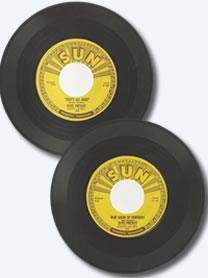 After Elvis had gone home, Sam called local DJ Dewey Phillips (No relation) and played him 'That's All Right' over the phone. Sam was convinced, but both men were acutely aware of the big question : What was it, really? The next morning, Dewey call Sam and asked to have two reference discs made - his hesitation was over, he wanted to play it on the show that night. When Dewey played the song that night, the switchboard 'lit up like a Christmas tree'. Calls kept coming in in and Dewey kept spinning the record - seemingly over and over, announcing that it was going to be a hit. No one knew it was the beginning of the phenomenal career of Elvis Presley, and arguably the birth of Rock 'n' Roll, and certainly modern music as we know it today.
After Elvis had gone home, Sam called local DJ Dewey Phillips (No relation) and played him 'That's All Right' over the phone. Sam was convinced, but both men were acutely aware of the big question : What was it, really? The next morning, Dewey call Sam and asked to have two reference discs made - his hesitation was over, he wanted to play it on the show that night. When Dewey played the song that night, the switchboard 'lit up like a Christmas tree'. Calls kept coming in in and Dewey kept spinning the record - seemingly over and over, announcing that it was going to be a hit. No one knew it was the beginning of the phenomenal career of Elvis Presley, and arguably the birth of Rock 'n' Roll, and certainly modern music as we know it today.
Interviewing Elvis on-air, Phillips asked him what high school he attended in order to clarify his color for the many callers who had assumed he was black.
Blue Moon Of Kentucky : The 'B' Side
A B-side was needed so on July 7 the trio again gathered at SUN with nothing prepared. Scotty Moore : 'Bill was the one who started to clown around singing the Bill Monroe song, Blue Moon Of Kentucky, imitating Bill Monroe in a high falsetto voice, but at a fast tempo, where as the original was done real slow. (But it can be said he was no imitating Elvis' performance on That's All Right). Elvis started singing along, with both singing high tenor. Things started to happen real fast. Two sided dubs were sent to nearby radio stations, including Bob Neal at WMPS and 'Sleepy-Eyed' John at WHHM. Concerned about control, Sam convinced Scotty Moore to take on Elvis' management, ensuring that the teenager would be insulated from opportunists.
It is interesting that Bill Monroe who wrote Blue Moon of Kentucky and recorded it with his Bluegrass Boys in 1946 re-recorded it himself in 4/4 time rather than the original 3/4 after hearing--and seeing--Elvis perform it and at theLouisiana Hayride. (See Peter Guralnick's Last Train to Memphis, pages 121-129, for a more detailed account of this interesting collision of musical worlds.) Sam Phillips was relieved when the country legend and 'founder' of Bluegrass offered praises rather than the anticipated scorn for Presley's version of his tune. At 19, Elvis somehow had the instinct to sing the song perfectly. Even the songwriter admitted it.
The First Live performances
The trio played publicly for the first time on July 17 at the Bon Air club - Elvis still sporting his child-size guitar.
At the end of the month, they appeared at the Overton Park Shell, with Slim Whitman headlining. A combination of his strong response to rhythm and nervousness at playing before a large crowd led Elvis to shake his legs as he performed: his wide-cut pants emphasized his movements, causing young women in the audience to start screaming. Moore recalled, 'During the instrumental parts he would back off from the mike and be playing and shaking, and the crowd would just go wild'. Black, a natural showman, whooped and rode his bass, hitting double licks that Elvis would later remember as 'really a wild sound, like a jungle drum or something'.
Soon after, Moore and Black quit their old band to play with Elvis regularly, and promoter Bob Neal became the trio's manager. From August through October, they played frequently at the Eagle's Nest club and returned to Sun Studio for more recording sessions, and Elvis quickly grew more confident on stage. According to Moore, 'His movement was a natural thing, but he was also very conscious of what got a reaction. He'd do something one time and then he would expand on it real quick'. Elvis made what would be his only appearance on Nashville's Grand Ole Opry on October 2; after a polite audience response, Opry manager Jim Denny told Phillips that his singer was 'not bad' but did not suit the program. Two weeks later, Elvis was booked on Louisiana Hayride, the Opry's chief, and more adventurous, rival. The Shreveport-based show was broadcast to 198 radio stations in 28 states. Elvis had another attack of nerves during the first set, which drew a muted reaction. A more composed and energetic second set inspired an enthusiastic response.
House drummer D.J. Fontana brought a new element, complementing Elvis' movements with accented beats that he had mastered playing in strip clubs. Soon after the show, the Hayride engaged Elvis for a year's worth of Saturday-night appearances. Trading in his old guitar for $8 (and seeing it promptly dispatched to the garbage), he purchased a Martin instrument for $175, and his trio began playing in new locales including Houston, Texas, and Texarkana, Arkansas. In October D.J. Fontana was hired to play drums for Elvis.
Using a very bare-bones drum kit, D.J. sat behind a curtain, unseen by the audience, and played behind Elvis and the boys as they performed the two songs allotted them, which were That's Alright Mama, and possibly (D.J.'s memory was a little sketchy) Blue Moon of Kentucky.
By early 1955, Elvis' regular Hayride appearances, constant touring, and well-received record releases had made him a substantial regional star, from Tennessee to West Texas. In January, Neal signed a formal management contract with Elvis and brought the singer to the attention of Colonel Tom Parker, whom he considered the best promoter in the music business. Parker, Dutch-born, though he claimed to be from West Virginia - had acquired an honorary colonel's commission from country singer turned Louisiana governor Jimmie Davis. Having successfully managed top country star Eddy Arnold, he was now working with the new number one country singer, Hank Snow. Parker booked Elvis on Snow's February tour. When the tour reached Odessa, Texas, a 19-year-old Roy Orbison saw Elvis for the first time: 'His energy was incredible, his instinct was just amazing, I just didn't know what to make of it. There was just no reference point in the culture to compare it'.
RCA and The Colonel
RCA Victor acquired Elvis' contract in a deal arranged by Colonel Tom Parker, who would go on to be his famous manager. Parker arranged with the owners of Hill and Range Publishing, Jean and Julian Aberbach, to create two entities, Elvis Presley Music and Gladys Music, to handle all of the new material recorded by Elvis. Songwriters were obliged to forego one third of their customary royalties in exchange for having him perform their compositions. By December, RCA had begun to heavily promote its new singer, and before month's end had reissued many of his Sun recordings. Elvis, at 20, was still a minor, so his father signed the contract.
Commercial breakout and controversy (1956-58) : First national TV appearances
On January 10, 1956, Elvis made his first recordings for RCA in Nashville. Extending the singer's by now customary backup of Scotty Moore, Bill Black, and D.J. Fontana, RCA enlisted pianist Floyd Cramer, guitarist Chet Atkins, and three background singers, including Gordon Stoker of the popular Jordanaires quartet, to fill out the sound. The session produced the moody, unusual Heartbreak Hotel, released as a single on January 27. Colonel Parker finally brought Elvis to national television, booking him on CBS's Stage Show for six appearances over two months. The program, produced in New York, was hosted on alternate weeks by big band leaders and brothers Tommy and Jimmy Dorsey. After his first appearance, on January 28, Elvis stayed in town to record at RCA's New York studio. The sessions yielded eight songs, including a cover of Carl Perkins' rockabilly anthem Blue Suede Shoes.
In February, Elvis' I Forgot to Remember to Forget, a Sun recording initially released the previous August, reached the top of the Billboard country chart. Neal's contract was terminated and, on March 2, Parker became Elvis' manager. RCA Victor released Elvis' self-titled debut album on March 23. Joined by five previously unreleased Sun recordings, its seven recently recorded tracks were of a broad variety. There were two country songs and a bouncy pop tune. The others would centrally define the evolving sound of rock and roll: Blue Suede Shoes - 'an improvement over Carl Perkins' in almost every way', according to critic Robert Hilburn - and three R&B numbers that had been part of Elvis' stage repertoire for some time, covers of Little Richard, Ray Charles, and The Drifters.
As described by Hilburn, these 'were the most revealing of all. Unlike many white artists, who watered down the gritty edges of the original R&B versions of songs in the '50s, Elvis reshaped them. He not only injected the tunes with his own vocal character but also made guitar, not piano, the lead instrument in all three cases'. It became the first rock and roll album to top the Billboard chart, a position it held for 10 weeks. While Elvis was not an innovative instrumentalist like Moore or contemporary African American rockers Bo Diddley and Chuck Berry, cultural historian Gilbert B. Rodman argues that the album's cover image, 'of Elvis having the time of his life on stage with a guitar in his hands played a crucial role in positioning the guitar, as the instrument that best captured the style and spirit of this new music'.
Historic Television Guest Appearances
In 1956, Elvis made his network television debut.
The first of his six appearances on Stage Show, a weekly variety program hosted by Tommy and Jimmy Dorsey. He followed these with two appearances on The Milton Berle Show, the second of which included a performance of Hound Dog that was so provocative (for that time, anyway) that it caused a national scandal. Elvis next appeared on The Steve Allen Show, with Allen mocking the sensation of the Berle appearance by having Elvis dress in a tuxedo, eliminate his usual physical gyrations, and sing Hound Dog to a Basset Hound.
 Elvis Presley - Ed Sullivan Show.
|
Ed Sullivan had once said he would never have the controversial singer on his top-rated show, but that was before the week that Elvis' appearance on Steve Allen had surpassed Sullivan's ratings.
After negotiating with Elvis' manager, Ed Sullivan paid Elvis the huge sum of $50,000 for appearing on three of his shows: September 9, 1956, October 28, 1956, and then on January 6, 1957. $50,000 was, at the time, more money than any performer had ever been paid to appear on a network variety program. Elvis' first appearance on The Ed Sullivan Show was a major success. Over 60 million people, both young and old, watched the show and many people believe it helped bridge the generation gap for Elvis' acceptance into the mainstream. Elvis performed, Don't Be Cruel, Love Me Tender, Ready Teddy and Hound Dog.
When Elvis made his third Sullivan appearance in January of 1957, Ed Sullivan surprised Elvis by telling him on camera that his show had never had a better experience with a name act, and said 'I wanted to say to Elvis and the country that this is a real decent, fine boy'.
It was on this very same Sullivan appearance that Elvis was shown on camera from the waist up only, one of early television history's most memorable moments. Elvis' next network television appearance was in 1960, when Frank Sinatra gave his variety show a 'Welcome Home, Elvis' theme to herald Elvis' return from the army. Elvis was paid $125,000 to appear - again, making history.

Barbara Gray reveals a secret.
Milton Berle Show and 'Hound Dog'
Elvis made the first of two appearances on NBC's Milton Berle Show on April 3. His performance, on the deck of the USS Hancock in San Diego, prompted cheers and screams from an audience of sailors and their dates. A few days later, a flight taking Elvis and his band to Nashville for a recording session left all three badly shaken when an engine died and the plane almost went down over Arkansas. Twelve weeks after its original release, Heartbreak Hotel became Elvis' first number one pop hit. In late April, Elvis began a two-week residency at the New Frontier Hotel and Casino on the Las Vegas Strip. The shows were poorly received by the conservative, middle-aged hotel guests - 'like a jug of corn liquor at a champagne party', wrote a critic for Newsweek.
Amid his Vegas tenure, Elvis, who had serious acting ambitions, signed a seven-year contract with Paramount Pictures. He began a tour of the Midwest in mid-May, taking in 15 cities in as many days. He had attended several shows by Freddie Bell and the Bellboys in Vegas, and was struck by their cover of Hound Dog, a hit in 1952 for blues singer Big Mama Thornton. It became the new closing number of his act. After a show in La Crosse, Wisconsin, an urgent message on the letterhead of the local Catholic diocese's newspaper was sent to FBI director J. Edgar Hoover. It warned that 'Elvis is a definite danger to the security of the United States, (His) actions and motions were such as to rouse the sexual passions of teenaged youth, After the show, more than 1,000 teenagers tried to gang into Elvis' room at the auditorium, Indications of the harm Elvis did just in La Crosse were the two high school girls, whose abdomen and thigh had Elvis' autograph'.
The second Milton Berle Show appearance came on June 5 at NBC's Hollywood studio, amid another hectic tour. Berle persuaded the singer to leave his guitar backstage, advising, 'Let 'em see you, son'. During the performance, Elvis abruptly halted an uptempo rendition of Hound Dog with a wave of his arm and launched into a slow, grinding version accentuated with energetic, exaggerated body movements.
Elvis' gyrations created a storm of controversy. Television critics were outraged: Jack Gould of The New York Times wrote, 'Mr. Elvis has no discernible singing ability, His phrasing, if it can be called that, consists of the stereotyped variations that go with a beginner's aria in a bathtub, His one specialty is an accented movement of the body, primarily identified with the repertoire of the blond bombshells of the burlesque runway'. Ben Gross of the New York Daily News opined that popular music 'has reached its lowest depths in the 'grunt and groin' antics of one Elvis Presley, Elvis, who rotates his pelvis, gave an exhibition that was suggestive and vulgar, tinged with the kind of animalism that should be confined to dives and bordellos'. Ed Sullivan, whose own variety show was the nation's most popular, declared him 'unfit for family viewing'.
To Elvis' displeasure, he soon found himself being referred to as 'Elvis the Pelvis', which he called 'one of the most childish expressions I ever heard, comin' from an adult'.
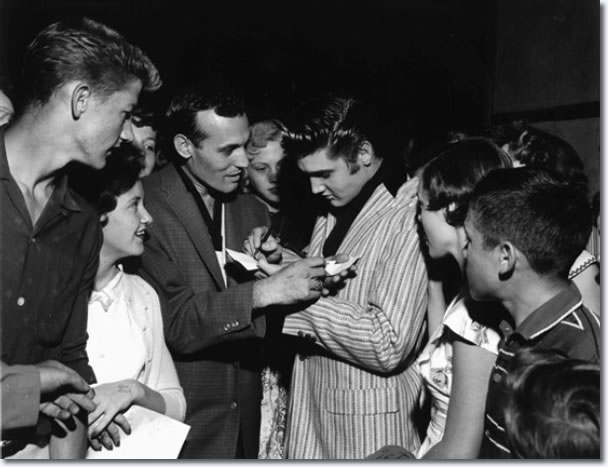
Carl Perkins and Elvis Presley swap autographs, Overton Park Shell, Memphis June 1, 1956.
Steve Allen Show and first Sullivan appearance
The Berle shows drew such high ratings that Elvis was booked for a July 1 appearance on NBC's The Steve Allen Showin New York. Allen, no fan of rock and roll, introduced a 'new Elvis' in a white bow tie and black tails. Elvis sang 'Hound Dog' for less than a minute to a basset hound wearing a top hat and bow tie.
As described by television historian Jake Austen, 'Allen thought Elvis was talentless and absurd, (he) set things up so that Elvis would show his contrition'. Allen, for his part, later wrote that he found Elvis' strange, gangly, country-boy charisma, his hard-to-define cuteness, and his charming eccentricity intriguing' and simply worked the singer into the customary 'comedy fabric' of his program.
Elvis would refer back to the Allen show as the most ridiculous performance of his career. Later that night, he appeared on  Elvis Hy Gardner Calling
Elvis Hy Gardner Calling  , a popular local TV show. Pressed on whether he had learned anything from the criticism to which he was being subjected, Elvis responded, 'No, I haven't, I don't feel like I'm doing anything wrong, I don't see how any type of music would have any bad influence on people when it's only music, I mean, how would rock 'n' roll music make anyone rebel against their parents?'
, a popular local TV show. Pressed on whether he had learned anything from the criticism to which he was being subjected, Elvis responded, 'No, I haven't, I don't feel like I'm doing anything wrong, I don't see how any type of music would have any bad influence on people when it's only music, I mean, how would rock 'n' roll music make anyone rebel against their parents?'
The next day, Elvis recorded Hound Dog, along with Any Way You Want Me and Don't Be Cruel. The Jordanaires sang harmony, as they had on The Steve Allen Show; they would work with Elvis through the 1960s. A few days later, the singer made an outdoor concert appearance in Memphis at which he announced, 'You know, those people in New York are not gonna change me none. I'm gonna show you what the real Elvis is like tonight'. In August, a judge in Jacksonville, Florida, ordered Elvis to tame his act. Throughout the following performance, he largely kept still, except for wiggling his little finger suggestively in mockery of the order. The single pairing Don't Be Cruel with Hound Dogruled the top of the charts for 11 weeks - a mark that would not be surpassed for 36 years. Recording sessions for Elvis' second album took place in Hollywood during the first week of September. Jerry Leiber and Mike Stoller, the writers of Hound Dog, contributed Love Me.
The Ed Sullivan Show
Allen's show with Elvis had, for the first time, beaten CBS's The Ed Sullivan Show in the ratings. Sullivan, despite his June pronouncement, booked the singer for three appearances for an unprecedented $50,000. The first, on September 9, 1956, was seen by approximately 60 million viewers - a record 82.6 percent of the television audience. Actor Charles Laughton hosted the show, filling in while Sullivan recuperated from a car accident. Elvis appeared in two segments that night from CBS Television City in Hollywood. According to Elvis legend, Elvis was shot only from the waist up. Watching clips of the Allen and Berle shows with his producer, Sullivan had opined that Elvis 'got some kind of device hanging down below the crotch of his pants - so when he moves his legs back and forth you can see the outline of his cock, I think it's a Coke bottle, We just can't have this on a Sunday night. This is a family show!' Sullivan publicly told TV Guide, 'As for his gyrations, the whole thing can be controlled with camera shots'.
In fact, Elvis was shown head-to-toe in the first and second shows. Though the camera work was relatively discreet during his debut, with leg-concealing close ups when he danced, the studio audience reacted in customary style: screaming. Elvis' performance of his forthcoming single, the ballad Love Me Tender, prompted a record-shattering million advance orders. More than any other single event, it was this first appearance on The Ed Sullivan Show that made Elvis a national celebrity of barely precedented proportions. Accompanying Elvis' rise to fame, a cultural shift was taking place that he both helped inspire and came to symbolize. Igniting the 'biggest pop craze since Glenn Miller and Frank Sinatra, Elvis brought rock'n'roll into the mainstream of popular culture', writes historian Marty Jezer. 'As Elvis set the artistic pace, other artists followed, Elvis, more than anyone else, gave the young a belief in themselves as a distinct and somehow unified generation - the first in America ever to feel the power of an integrated youth culture'.
 Elvis Presley on National TV
Elvis Presley on National TV
Elvis Presley's Graceland
Graceland, Elvis Presley's home and refuge for twenty years, is one of the most visited homes in America today, now attracting over 600,000 visitors annually. It is also the most famous home in America after the White House. In 1991, Graceland Mansion was placed on the National Register of Historic Places.

Elvis Presley's Graceland - 3764 Elvis Presley Boulevard.
Military service and mother's death (1958-60)
On March 24, 1958, Elvis was inducted into the U.S. Army as a private at Fort Chaffee, near Fort Smith, Arkansas. Captain Arlie Metheny, the information officer, was unprepared for the media attention drawn by the singer's arrival. Hundreds of people descended on Elvis as he stepped from the bus; photographers then accompanied him into the base. Elvis announced that he was looking forward to his military stint, saying he did not want to be treated any differently from anyone else: 'The Army can do anything it wants with me'. Later, at Fort Hood, Texas, Lieutenant Colonel Marjorie Schulten gave the media carte blanche for one day, after which she declared Elvis off-limits to the press. Soon after Elvis had commenced basic training at Fort Hood, he received a visit from Eddie Fadal, a businessman he had met when on tour in Texas. Fadal reported that Elvis had become convinced his career was finished - 'He firmly believed that'.
During a two-week leave in early June, Elvis cut five sides in Nashville. He returned to training, but in early August his mother was diagnosed with hepatitis and her condition worsened. Elvis was granted emergency leave to visit her, arriving in Memphis on August 12. Two days later, Gladys died of heart failure, aged 46. Elvis was devastated; their relationship had remained extremely close - even into his adulthood, they would use baby talk with each other and Elvis would address her with pet names.
After training at Fort Hood, Elvis joined the 3rd Armored Division in Friedberg, Germany, on October 1. The Army also introduced Elvis to karate, which he studied seriously, later including it in his live performances. Fellow soldiers have attested to Elvis' wish to be seen as an able, ordinary soldier, despite his fame, and to his generosity while in the service. He donated his Army pay to charity, purchased TV sets for the base, and bought an extra set of fatigues for everyone in his outfit.
While in Friedberg, Elvis met 14-year-old Priscilla Beaulieu. They would eventually marry after a seven-and-a-half-year courtship. In her autobiography, Priscilla says that despite his worries that it would ruin his career, Parker convinced Elvis that to gain popular respect, he should serve his country as a regular soldier rather than in Special Services, where he would have been able to give some musical performances and remain in touch with the public. Media reports echoed Elvis' concerns about his career, but RCA producer Steve Sholes and Freddy Bienstock of Hill and Range had carefully prepared for his two-year hiatus. Armed with a substantial amount of unreleased material, they kept up a regular stream of successful releases. Between his induction and discharge, Elvis had ten top 40 hits, including Wear My Ring Around Your Neck, the best-selling Hard Headed Woman, and One Night in 1958, and (Now and Then There's) A Fool Such as I and the number one A Big Hunk O' Love in 1959. RCA also managed to generate four albums compiling old material during this period, most successfully Elvis' Golden Records (1958), which hit number three on the LP chart.
 Elvis Presley In The U.S. Army
Elvis Presley In The U.S. Army
Focus on movies (1960-67) : Elvis Is Back
Elvis returned to the United States on March 2, 1960, and was honorably discharged with the rank of sergeant onMarch 5. The train that carried him from New Jersey to Tennessee was mobbed all the way, and Elvis was called upon to appear at scheduled stops to please his fans. Back in Memphis, he wasted no time in returning to the studio. Sessions in March and April yielded two of his best-selling singles, the ballads It's Now or Never and Are You Lonesome Tonight?, and Elvis Is Back! The album features several songs described by Greil Marcus as full of Chicago blues 'menace, driven by Elvis' own super-miked acoustic guitar, brilliant playing by Scotty Moore, and demonic sax work from Boots Randolph. Elvis' singing wasn't sexy, it was pornographic'.
As a whole, the record 'conjured up the vision of a performer who could be all things', in the words of music historian John Robertson: 'a flirtatious teenage idol with a heart of gold; a tempestuous, dangerous lover; a gutbucket blues singer; a sophisticated nightclub entertainer; (a) raucous rocker'. Released only days after recording was complete, it reached number two on the album chart.
Elvis returned to television on May 12 as a guest on The Frank Sinatra Timex Special - ironic for both stars, given Sinatra's not-so-distant excoriation of rock and roll. Also known as Welcome Home Elvis, the show had been taped in late March, the only time all year Elvis performed in front of an audience. Parker secured an unheard-of $125,000 fee for eight minutes of singing. The broadcast drew an enormous viewership.
It is important to note that at the time Elvis came to prominence it was the normal thing for a big star in the music field to cross over to movies. They did not have the technology nor music videos, MTV etc. So Hollywood it was, and it was Elvis' dream to be a good actor, he held out hope for years that he would be given a good script and succeed in the movie business, eventually accepting this was not to be ...

Ann-Margret talks about Elvis.
Elvis Presley starred in 31 feature films as an actor and two theatrically released concert documentary films, all of which enjoyed financial success. For a number of years he was one of Hollywood's top box office draws and one of its highest-paid actors. His two most critically acclaimed films, Jailhouse Rock (1957) and King Creole (1958) have become classics of their era. His movies and concert films enjoy a healthy life today in television syndication and home video sales and rentals. Some of his top-selling music came from his movies. Eleven of his movie soundtrack albums went to the top ten, and of those, four went to number one.
The soundtrack for G.I. Blues (1960), was number one on the Billboard Top 100 album chart for 10 weeks and remained on the chart for 111 weeks. The album from Blue Hawaii was number one for 20 weeks and was on the chart for 79 weeks G.I. Blues, the soundtrack to Elvis' first film since his return, was a number one album in October. His first LP of sacred material, His Hand in Mine, followed two months later. It reached number 13 on the U.S. pop chart and number 3 in Great Britain, remarkable figures for a gospel album.
In February 1961, Elvis performed two shows for a benefit event in Memphis, on behalf of 24 local charities. During a luncheon preceding the event, RCA presented him with a plaque certifying worldwide sales of over 75 million records. A 12-hour Nashville session in mid-March yielded nearly all of Elvis' next studio album, Something for Everybody. As described by John Robertson, it exemplifies the Nashville sound, the restrained, cosmopolitan style that would define country music in the 1960s. Presaging much of what was to come from Elvis himself over the next half-decade, the album is largely 'a pleasant, unthreatening pastiche of the music that had once been Elvis' birthright'. It would be his sixth number one LP. Another benefit concert, raising money for a Pearl Harbor memorial, was staged on March 25, in Hawaii. It was to be Elvis' last public performance for seven years.
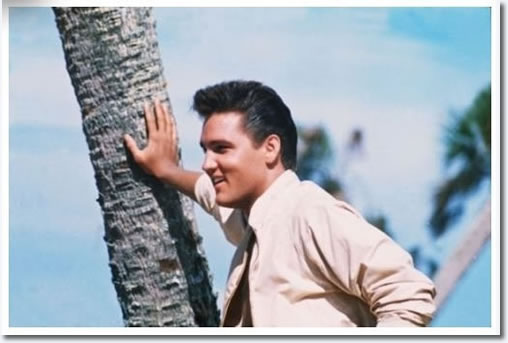
On location for the picture 'Follow That Dream'.
 When it comes to Americana, Elvis is right up there with the hamburger, Marilyn Monroe and apple pie. He’s about as American as it gets. So, in many respects, it’s fitting that the “King” died on his throne (in the private bathroom of his Graceland mansion) from a drug overdose at the age of 42. Because after all, aren’t drugs as American as apple pie as well?
When it comes to Americana, Elvis is right up there with the hamburger, Marilyn Monroe and apple pie. He’s about as American as it gets. So, in many respects, it’s fitting that the “King” died on his throne (in the private bathroom of his Graceland mansion) from a drug overdose at the age of 42. Because after all, aren’t drugs as American as apple pie as well? New topic
New topic Printable
Printable
 Report post to moderator
Report post to moderator





 After Elvis had gone home, Sam called local DJ Dewey Phillips (No relation) and played him 'That's All Right' over the phone. Sam was convinced, but both men were acutely aware of the big question : What was it, really? The next morning, Dewey call Sam and asked to have two reference discs made - his hesitation was over, he wanted to play it on the show that night. When Dewey played the song that night, the switchboard 'lit up like a Christmas tree'. Calls kept coming in in and Dewey kept spinning the record - seemingly over and over, announcing that it was going to be a hit. No one knew it was the beginning of the phenomenal career of Elvis Presley, and arguably the birth of Rock 'n' Roll, and certainly modern music as we know it today.
After Elvis had gone home, Sam called local DJ Dewey Phillips (No relation) and played him 'That's All Right' over the phone. Sam was convinced, but both men were acutely aware of the big question : What was it, really? The next morning, Dewey call Sam and asked to have two reference discs made - his hesitation was over, he wanted to play it on the show that night. When Dewey played the song that night, the switchboard 'lit up like a Christmas tree'. Calls kept coming in in and Dewey kept spinning the record - seemingly over and over, announcing that it was going to be a hit. No one knew it was the beginning of the phenomenal career of Elvis Presley, and arguably the birth of Rock 'n' Roll, and certainly modern music as we know it today.









